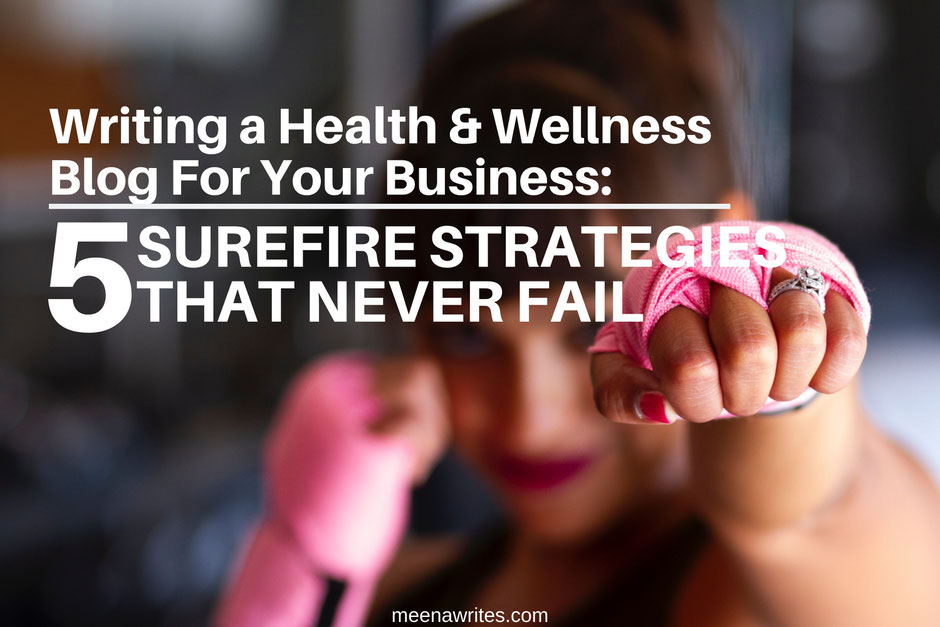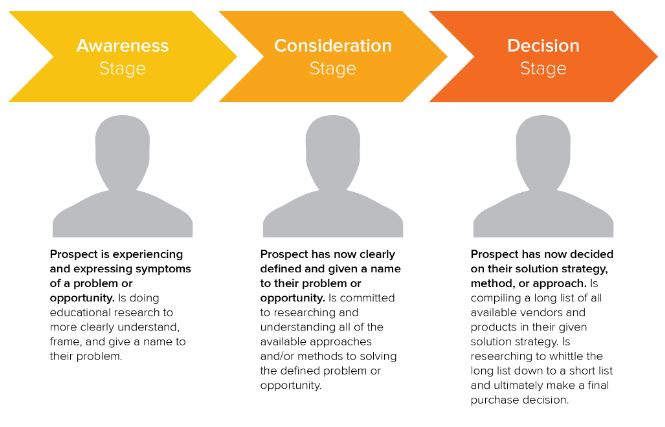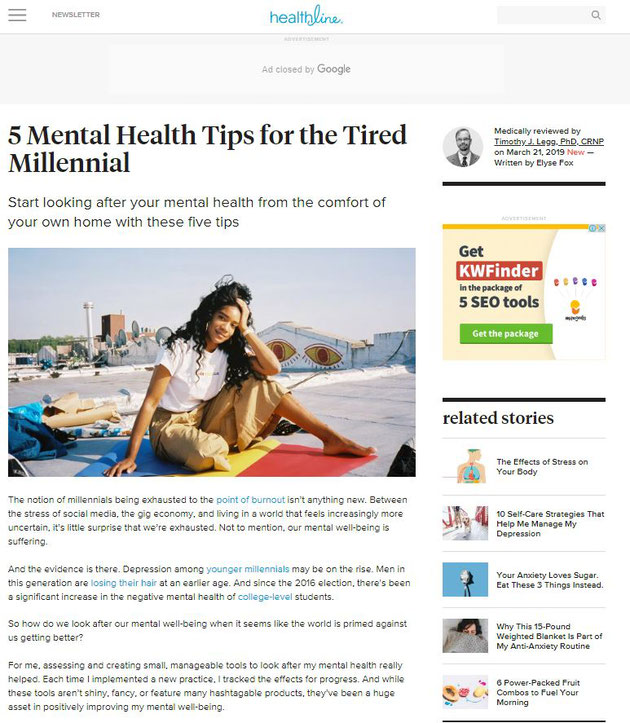
How to write a health & wellness blog for your business: 5 simple & effective strategies
A health and wellness blog on your website is a rich source of information for your audience. And as an expert in health and wellbeing, you have plenty to say.
What's more, people like getting information about health and wellness from blogs. This means that they take the advice and information given in a blog post quite seriously.
A health and wellness blog essentially transforms evidence-based scientific information and knowledge into simple, fun and engaging content.
Simply put, a health and wellness blog does not read like an academic journal. Instead, it conveys important information including research in an enjoyable format.
But the art of "blogifying" all that critical information so that your readers are engaged, is a craft that needs learning.
Having written blog posts for several health and wellness businesses, I have learnt a few things over the years about crafting a compelling blog post so that it is conversational, inspiring and easy to understand.
Here are five simple and effective strategies which I think are important when you start writing a health and wellbeing blog post:
1. Choose a health and wellness topic and a perspective
You're the expert. You probably have a lot to write about. And that is fantastic! There is no one better than you who knows your area of expertise.
But writing a blog post is not an impromptu activity. It's crucial for you to understand why you are writing and to whom.
Are you talking to a particular type of client or customer? Are you addressing a specific pain point or query of that client? Do you think your customers are interested in what you’re saying or would they like to read about another angle or perspective on that topic?
One of the prime goals of your business is to grow. And that is only possible if you attract the kind of prospects you want to help and serve.
That’s why the first step in writing a blog is figuring out who your ideal clients are.
In marketing terms, an ideal client is also known as a buyer persona and here is an easy guide to help you find yours.
Once you know whom you’re talking to, you can then figure out what perspective to take on a blog topic. For example, if I am writing a post titled ‘how to write a blog post’, I could write it in a few different ways. It depends on the type of reader that I am targeting. So if I were addressing a new blogger who wants to learn how to write a blog post, I would give them a step-by-step approach to writing a compelling blog article.
But in this case, I am addressing you — a health and wellness business. You probably know the basics of writing a blog but may want to learn about the specifics of writing a health and wellness blog post for your business so that it delivers results and established you as an authority in your field.
Perspective is what makes your blog post different from someone else’s post on the same topic. If you trawl the internet, you will find many blog posts on the subject that you want to write about. It’s already been done. And people have already read about it.
But can you write something different? Add a new perspective? Perhaps you have a different way of doing things and have achieved excellent results which you want to share. Or maybe you want to write about new research on that topic. Or share a client story.
Even if that topic has been written about before, what and how you write your blog post makes a difference to your target audience depending on where they are in their buyer’s journey.
The buyer’s journey is a process which takes your buyer through three stages — awareness, consideration and decision stage— before they become your clients or customers. What they need at each point of their journey will change as they move forward.
In the Awareness stage, your prospect may not be aware that he/she has a problem, or that they may be experiencing symptoms of a problem but don’t know how to define it. While in the Consideration stage, they figure out what their actual problem is but don’t know what can be done to solve this problem. In the Decision stage the prospect understands how this problem can be solved and is now looking for the best option. This means that your prospect is getting ready to make a purchase.
You readers will need different types of educational content including blogs as they proceed through these stages before they make a purchase from you.
It helps to understand the needs of your target reader at each stage and provide them with content which “speaks” to them, giving them the information they need and providing them with helpful advice. When you map blog posts to the buyer's needs at each stage of the journey, you succeed in engaging with them considerably.

2. Research and back up claims
Researching the topic is the key to writing an informative article. When you examine the problem you are writing about, it expands your knowledge of the subject which helps you write with fluency.
You may know a lot about your area of expertise and probably think that you don't need to research, but that’s where you can lose sight of vital information and perhaps your perspective. Even if you are the expert, researching the topic keeps you up to date with new information, magnifies your knowledge base and also gives you insight into a different perspective.
Besides, you will be surprised to see how many other topic ideas pop up in your head as you dig deep into data, figures and information.
Research serves another fundamental purpose, and that is to gather vital evidence needed to back up any claims you make in a blog post.
Validating any claims is essential in health and wellness blog post writing as it verifies what you are saying and your readers are more likely to trust you. This way you ensure that you provide accurate information to your audience which helps to establish your credibility further.
For example, if you wrote “Yoga is known to alleviate chronic lower back pain “, then make sure you back that up by linking to relevant research or by elaborating on that research a little more. In any case, it is best practice to add a link so that your readers can read more about that specific study if they want to.
If you choose to write more about the research, make sure you mention essential details such as who conducted the research, where and when it was published and what was studied.
Researching is also vital when you are writing about something which is not in your area of expertise. If you are thinking that you'll always stick to the topic you know about, then you are wrong. The goal of having a business blog is to be a resource for your audience. Your aim should be to inform and be helpful to your reader. This means that when your audience is looking for help with a specific problem you are giving them as much information as you can so that they can take action which will help them further.
For example, you are a Chiropractor but you also want to give your readers some information about healthy eating. In this case, it would help you to research healthy eating habits and diet and even talk to a nutritionist to gather key information.
Always link to credible sources. This means making sure that academic articles are peer-reviewed, up-to-date and trustworthy. If you’re linking to any website, make sure they are reputable websites. Other places to look for reliable sources are libraries, government websites, not-for-profits and official associations.
Linking to other helpful resources and websites makes your blog a valuable source of information and shows your readers that you care about them to include further material so that they can learn some more.
Linking is also great for SEO, but it’s essential to link to reputable sources. Search engines get a clear picture of what your website is all about as you begin to link to relevant sources and this establishes trust in your site.
3. Provide testimonials and expert comments
Testimonials from past clients are a great way to establish your credibility. Include their experiences in your blog post so that other readers can relate to their story. Adding other people’s stories goes a long way in humanising the post and making it believable.
So does adding expert comments. While you are the expert, corroborating what you say with evidence from other experts makes your blog post realistic. The added comments increases trust factor as your readers can see that other experts are voicing what you are saying.
Besides, including expert comments increases the reach of your blog post as these experts are likely to share the post with their fans and followers, thus bringing in more traffic to your website and blog.
4. Address your readers - first, second or third person
When you write your blog post in the first person, you are taking a personal approach to connecting with your readers. At the same time, you are stating your authority when you use the word “I”. In this case, there is no room for making passive claims. Even when you use expert interviews in your blog post, your reader is going to take your word as the authority on the topic.
When you write in the first person, you take ownership of what you say. So think carefully about what you want to say before you hit the publish button. You don’t want the blog post to sound like you are reflecting and rambling on about your personal experiences without offering any helpful information which is relevant to your reader.
However, writing in the first person often lends more intimacy to the blog post and can be an effective way for health and wellness businesses to connect with their audience. When you place yourself in the post, you are telling your audience about your personal experiences, your feeling and emotions, and how you respond to them. You readers feel a stronger connection to you as they feel like you are talking to them about your life.
But this style of writing does not work with every kind of health and wellness business.

When you as the person are the business, and you are the brand, then first-person blog posts can work well. Individuals like Sarah Wilson, who is also a health and wellness professional uses first-person narratives.
When businesses are talking about themselves, it’s always better to use the first-person word “we” or “our” rather than the business name in the blog post. For example: “Our new research on lower back pain shows that….” or “We have made many new discoveries in the past few years…”
Third person blogs are generally written by a company or business that wants to put a distance between the writer and the topics they are writing about. The idea behind this is to appear more objective, and this is important when you are conveying vital evidence-based health information such as Allina Health’s blog posts which are written in the third person by various medical experts. Healthline too provides “expert content” written in the third person.
Whether you write in first person or a third person will depend on your business, your goals and how you want to connect with your target audience. However, the most essential writing style that you should adopt in your blog is the use of second-person writing. In this case, you are using the word “you” often and are addressing your reader in the story. In this style, you place the reader first and put them at centre-stage.
After all, your blog post is about your reader, about talking to them, about giving them vital information, about empowering them and about helping your audience live better lives.
Whether you are writing from a personal perspective or taking a third person objective approach, addressing your reader is what makes a blog post impressionable, conversational and personal.

5. Guide readers to the next step
Ultimately, you want your readers to get something out of the blog post. It could mean that you want your audience to understand the topic better, give them new information which is vital to their health, change their behaviour or improve their health.
Write your health and wellness article with the end results in mind. This will guide your writing and help your draft your blog post in cohesive, logical sections.
Always guide your reader towards the next step after they finish reading the blog post. What should they do? Where should they go from there?
You can link to another post for them to read, or guide them to an association where they can get more information or help. You can ask them to sign up for a newsletter or leave a comment. Or you can guide them to a lead magnet where they can sign in for a freebie resource, product or service which will help them in some way.
Conclusion
A successful health and wellness business blog is a fantastic marketing tool. But more than that, it is a resource to help your readers along their journey to better health.
With these five simple strategies, you can create a health and wellness blog which is successful in engaging with your audience and effective in delivering vital information which can enhance their health and wellbeing.
If you are wondering how to start a health and wellness blog, here are 3 free blog posts templates which will get you started. Click the link below!
If you need help writing health and wellness related blog posts for your business, please contact Meena Writes for a chat today.
Want to pin this post?
Share the love with these Pinterest-friendly images! Thanks x





Write a comment
Aria Akachi (Friday, 23 August 2019 04:08)
how to find a target audience to your blog and how many links would be added in the blog.
CareActive (Monday, 09 September 2019 06:04)
It's really a useful blog. It helps me a lot to plan how I need to write the blog
assignment expert (Thursday, 24 October 2019 00:48)
very nice blog that you have shared
Spencer Pearson (Thursday, 21 November 2019 02:50)
It's really a useful blog
CareActive (Monday, 10 February 2020 22:53)
Great blog, helps a lot for writing a good blog. Thanks for sharing.
Dorothy (Monday, 02 March 2020 05:03)
I am currently starting my career as a health and wellness writer. I am glad I found this post, it IS very insightful.
Thanks!
Dina (Saturday, 18 July 2020 17:39)
very informative
Aqsa bibi (Saturday, 09 January 2021 04:05)
It was informaive, it helps me a lot.
Kendel Lallyson (Friday, 05 March 2021 07:11)
Love this! Thank you for sharing!
Pure Natura (Sunday, 16 May 2021 15:32)
Hi, amazing info, thanks for sharing. Post some more of these useful tips
Matsiko Gift (Thursday, 09 September 2021 06:22)
Amazing piece of work , this info will help me improve my content .thank you.
Venessa (Tuesday, 07 May 2024 15:30)
Wonderful blog Meena. Very insightful indeed. I enjoyed reading it very much as it was clear and to the point. Thank you for putting together such a great piece of information.